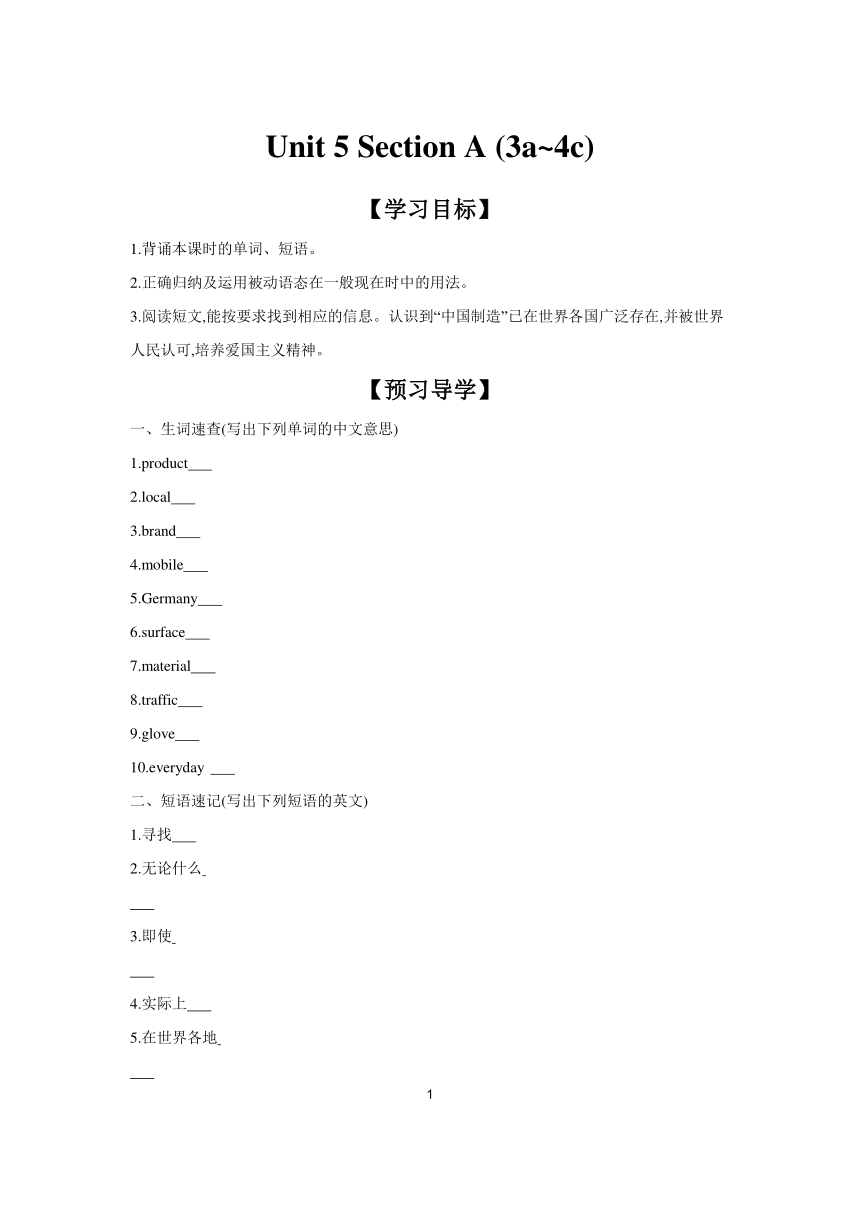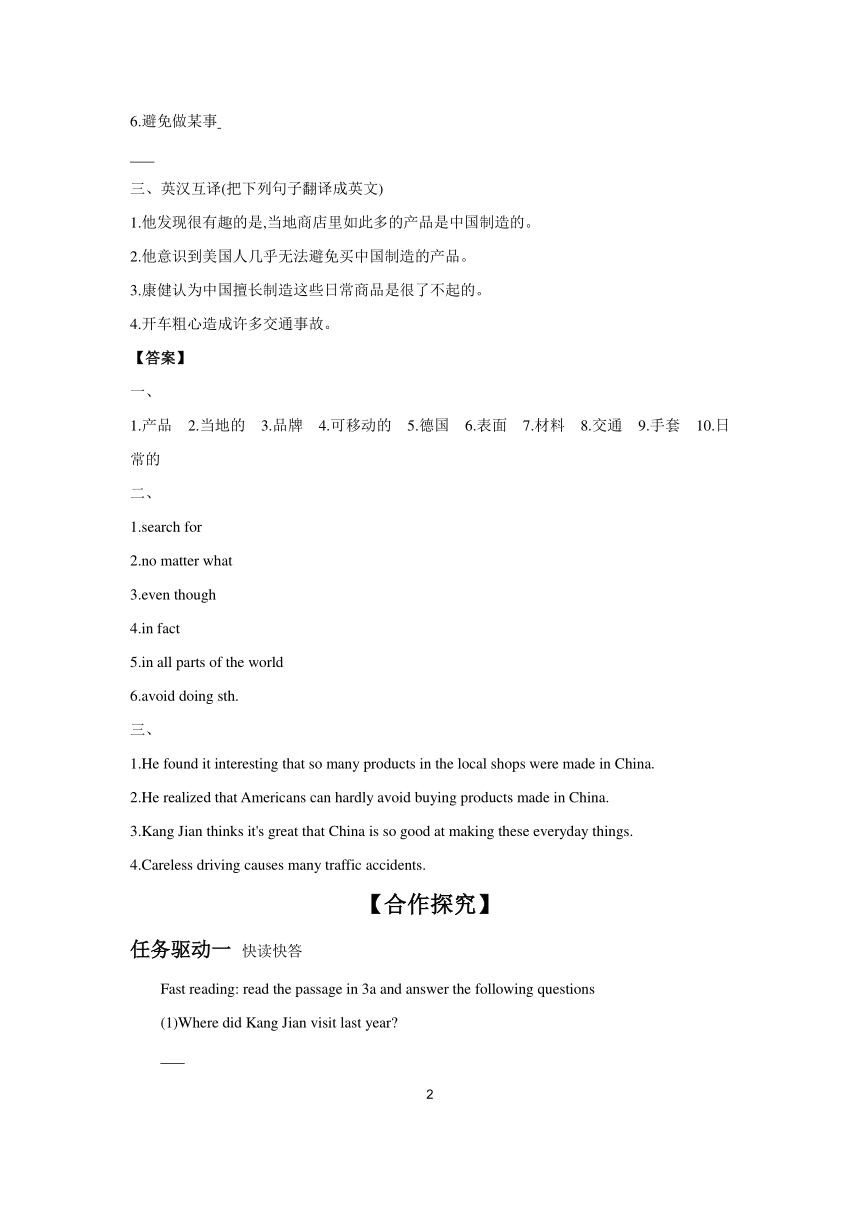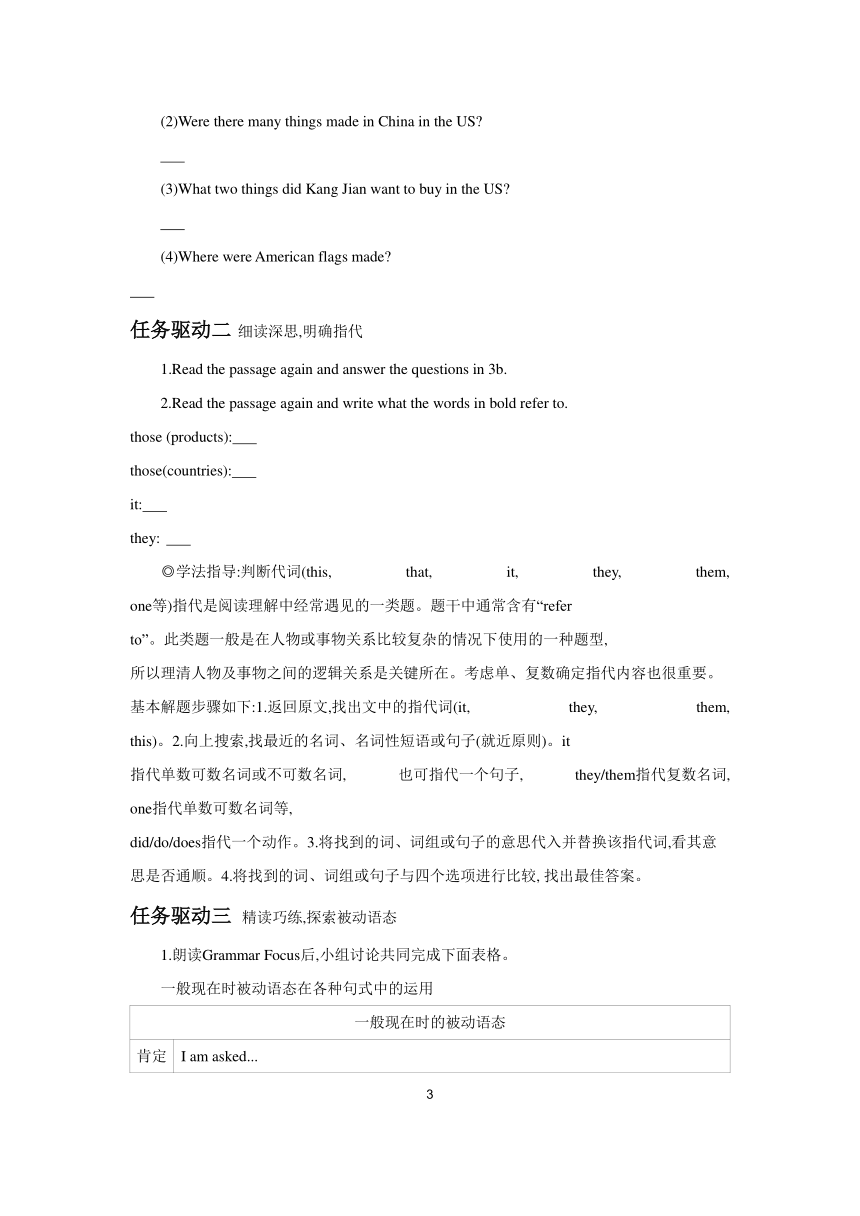Unit 5 What are the shirts made of?Section A (3a~4c) 学案 人教版九年级全一册(含答案)
文档属性
| 名称 | Unit 5 What are the shirts made of?Section A (3a~4c) 学案 人教版九年级全一册(含答案) |  | |
| 格式 | docx | ||
| 文件大小 | 50.0KB | ||
| 资源类型 | 教案 | ||
| 版本资源 | 人教新目标(Go for it)版 | ||
| 科目 | 英语 | ||
| 更新时间 | 2024-02-21 16:41:36 | ||
图片预览



文档简介
Unit 5 Section A (3a~4c)
【学习目标】
1.背诵本课时的单词、短语。
2.正确归纳及运用被动语态在一般现在时中的用法。
3.阅读短文,能按要求找到相应的信息。认识到“中国制造”已在世界各国广泛存在,并被世界人民认可,培养爱国主义精神。
【预习导学】
一、生词速查(写出下列单词的中文意思)
1.product
2.local
3.brand
4.mobile
5.Germany
6.surface
7.material
8.traffic
9.glove
10.everyday
二、短语速记(写出下列短语的英文)
1.寻找
2.无论什么
3.即使
4.实际上
5.在世界各地
6.避免做某事
三、英汉互译(把下列句子翻译成英文)
1.他发现很有趣的是,当地商店里如此多的产品是中国制造的。
2.他意识到美国人几乎无法避免买中国制造的产品。
3.康健认为中国擅长制造这些日常商品是很了不起的。
4.开车粗心造成许多交通事故。
【答案】
一、
1.产品 2.当地的 3.品牌 4.可移动的 5.德国 6.表面 7.材料 8.交通 9.手套 10.日常的
二、
1.search for
2.no matter what
3.even though
4.in fact
5.in all parts of the world
6.avoid doing sth.
三、
1.He found it interesting that so many products in the local shops were made in China.
2.He realized that Americans can hardly avoid buying products made in China.
3.Kang Jian thinks it's great that China is so good at making these everyday things.
4.Careless driving causes many traffic accidents.
【合作探究】
任务驱动一 快读快答
Fast reading: read the passage in 3a and answer the following questions
(1)Where did Kang Jian visit last year
(2)Were there many things made in China in the US
(3)What two things did Kang Jian want to buy in the US
(4)Where were American flags made
任务驱动二 细读深思,明确指代
1.Read the passage again and answer the questions in 3b.
2.Read the passage again and write what the words in bold refer to.
those (products):
those(countries):
it:
they:
◎学法指导:判断代词(this, that, it, they, them, one等)指代是阅读理解中经常遇见的一类题。题干中通常含有“refer to”。此类题一般是在人物或事物关系比较复杂的情况下使用的一种题型, 所以理清人物及事物之间的逻辑关系是关键所在。考虑单、复数确定指代内容也很重要。基本解题步骤如下:1.返回原文,找出文中的指代词(it, they, them, this)。2.向上搜索,找最近的名词、名词性短语或句子(就近原则)。it 指代单数可数名词或不可数名词, 也可指代一个句子, they/them指代复数名词, one指代单数可数名词等, did/do/does指代一个动作。3.将找到的词、词组或句子的意思代入并替换该指代词,看其意思是否通顺。4.将找到的词、词组或句子与四个选项进行比较, 找出最佳答案。
任务驱动三 精读巧练,探索被动语态
1.朗读Grammar Focus后,小组讨论共同完成下面表格。
一般现在时被动语态在各种句式中的运用
一般现在时的被动语态
肯定式 I am asked... He/She is asked... We/You/They are asked...
否定式 I am not asked... He/She asked... We/You/They asked...
疑问式 Are you asked... he/she ... you/they ...
2.广告设计,产品推广。
小组共同完成一件产品的广告设计及说明,要求图文并茂,文字说明突出产品特色、产地、用途。展示并选出最佳设计。
◎学法指导:主动语态变为被动语态的方法
先确定主动句的主、谓、宾, 再将主动句的宾语变成被动句的 , 主动句的主语变成被动句中介词“by”的 (没必要说出动作的执行者时可略去“by+宾语”); 主动句的谓语动词要变成“助动词be+及物动词的过去分词”, 但时态不能改变; 变化时还得注意“数”(助动词要与新的主语保持“数”的一致)和“格”(若主语和宾语是人称代词, “宾作主”时宾格要变成主格, “主作宾”时主格要变成宾格); 时间状语、地点状语等其余部分可重现于被动句中。例如:
【答案】
任务驱动一
1)San Francisco.
2)Yes, there were.
3)A toy car and a pair of basketball shoes.
4)They were made in China.
任务驱动二
a camera, some beautiful clothes and a watch...
Japan, France and Switzerland...
the fact that so many products in the local shops were made in China
toys
任务驱动三
is not/isn't are not/aren't Is asked Are asked
主语 宾语
【知识超市】
[命题点一]
No matter what you may buy, you might think those products were made in those countries. 无论你买什么, 你可能会想到那些产品是在那些国家制造的。
◎观察思考:
Don't believe him, no matter what he says.
不管他说什么, 你都不要相信。
◎用法总结:no matter意为“不管……; 不论……”, 后可接what, when, who等从属连词引导让步状语从句。从句的语序必须是陈述语序。 no matter what = ; = whenever;no matter who = 。
对点自测
翻译句子
1.无论何时你来这里, 我都会热烈欢迎你。
you come here, I will welcome you warmly.
2.无论你做什么,我都会一直支持你。
you do, I will support you all the time.
[命题点二]
He realized that Americans can hardly avoid buying products made in China.他意识到美国人几乎不能避免买中国制造的产品。
◎观察思考:
1.I think she is avoiding me. 我想她是在躲着我。
2.Try to avoid accidents. 尽量防止发生事故。
◎用法总结:avoid作动词, 可表示“避开”或“躲避某人或某物”, 也可表示“防止某事的发生”。其后可接名词或代词作宾语, 也可接动名词作宾语, 但是不能接不定式作宾语。
对点自测
1.我选择了一条小路来避开高峰时的车流。(翻译)
I chose to take a path to the rush-hour traffic.
2.I will try my best to avoid (make)the same mistakes again.
【答案】命题点一
用法总结
whatever no matter when whoever
对点自测
1.Whenever/No matter when
2.Whatever/No matter what
命题点二
对点自测
1.avoid 2.making
2
【学习目标】
1.背诵本课时的单词、短语。
2.正确归纳及运用被动语态在一般现在时中的用法。
3.阅读短文,能按要求找到相应的信息。认识到“中国制造”已在世界各国广泛存在,并被世界人民认可,培养爱国主义精神。
【预习导学】
一、生词速查(写出下列单词的中文意思)
1.product
2.local
3.brand
4.mobile
5.Germany
6.surface
7.material
8.traffic
9.glove
10.everyday
二、短语速记(写出下列短语的英文)
1.寻找
2.无论什么
3.即使
4.实际上
5.在世界各地
6.避免做某事
三、英汉互译(把下列句子翻译成英文)
1.他发现很有趣的是,当地商店里如此多的产品是中国制造的。
2.他意识到美国人几乎无法避免买中国制造的产品。
3.康健认为中国擅长制造这些日常商品是很了不起的。
4.开车粗心造成许多交通事故。
【答案】
一、
1.产品 2.当地的 3.品牌 4.可移动的 5.德国 6.表面 7.材料 8.交通 9.手套 10.日常的
二、
1.search for
2.no matter what
3.even though
4.in fact
5.in all parts of the world
6.avoid doing sth.
三、
1.He found it interesting that so many products in the local shops were made in China.
2.He realized that Americans can hardly avoid buying products made in China.
3.Kang Jian thinks it's great that China is so good at making these everyday things.
4.Careless driving causes many traffic accidents.
【合作探究】
任务驱动一 快读快答
Fast reading: read the passage in 3a and answer the following questions
(1)Where did Kang Jian visit last year
(2)Were there many things made in China in the US
(3)What two things did Kang Jian want to buy in the US
(4)Where were American flags made
任务驱动二 细读深思,明确指代
1.Read the passage again and answer the questions in 3b.
2.Read the passage again and write what the words in bold refer to.
those (products):
those(countries):
it:
they:
◎学法指导:判断代词(this, that, it, they, them, one等)指代是阅读理解中经常遇见的一类题。题干中通常含有“refer to”。此类题一般是在人物或事物关系比较复杂的情况下使用的一种题型, 所以理清人物及事物之间的逻辑关系是关键所在。考虑单、复数确定指代内容也很重要。基本解题步骤如下:1.返回原文,找出文中的指代词(it, they, them, this)。2.向上搜索,找最近的名词、名词性短语或句子(就近原则)。it 指代单数可数名词或不可数名词, 也可指代一个句子, they/them指代复数名词, one指代单数可数名词等, did/do/does指代一个动作。3.将找到的词、词组或句子的意思代入并替换该指代词,看其意思是否通顺。4.将找到的词、词组或句子与四个选项进行比较, 找出最佳答案。
任务驱动三 精读巧练,探索被动语态
1.朗读Grammar Focus后,小组讨论共同完成下面表格。
一般现在时被动语态在各种句式中的运用
一般现在时的被动语态
肯定式 I am asked... He/She is asked... We/You/They are asked...
否定式 I am not asked... He/She asked... We/You/They asked...
疑问式 Are you asked... he/she ... you/they ...
2.广告设计,产品推广。
小组共同完成一件产品的广告设计及说明,要求图文并茂,文字说明突出产品特色、产地、用途。展示并选出最佳设计。
◎学法指导:主动语态变为被动语态的方法
先确定主动句的主、谓、宾, 再将主动句的宾语变成被动句的 , 主动句的主语变成被动句中介词“by”的 (没必要说出动作的执行者时可略去“by+宾语”); 主动句的谓语动词要变成“助动词be+及物动词的过去分词”, 但时态不能改变; 变化时还得注意“数”(助动词要与新的主语保持“数”的一致)和“格”(若主语和宾语是人称代词, “宾作主”时宾格要变成主格, “主作宾”时主格要变成宾格); 时间状语、地点状语等其余部分可重现于被动句中。例如:
【答案】
任务驱动一
1)San Francisco.
2)Yes, there were.
3)A toy car and a pair of basketball shoes.
4)They were made in China.
任务驱动二
a camera, some beautiful clothes and a watch...
Japan, France and Switzerland...
the fact that so many products in the local shops were made in China
toys
任务驱动三
is not/isn't are not/aren't Is asked Are asked
主语 宾语
【知识超市】
[命题点一]
No matter what you may buy, you might think those products were made in those countries. 无论你买什么, 你可能会想到那些产品是在那些国家制造的。
◎观察思考:
Don't believe him, no matter what he says.
不管他说什么, 你都不要相信。
◎用法总结:no matter意为“不管……; 不论……”, 后可接what, when, who等从属连词引导让步状语从句。从句的语序必须是陈述语序。 no matter what = ; = whenever;no matter who = 。
对点自测
翻译句子
1.无论何时你来这里, 我都会热烈欢迎你。
you come here, I will welcome you warmly.
2.无论你做什么,我都会一直支持你。
you do, I will support you all the time.
[命题点二]
He realized that Americans can hardly avoid buying products made in China.他意识到美国人几乎不能避免买中国制造的产品。
◎观察思考:
1.I think she is avoiding me. 我想她是在躲着我。
2.Try to avoid accidents. 尽量防止发生事故。
◎用法总结:avoid作动词, 可表示“避开”或“躲避某人或某物”, 也可表示“防止某事的发生”。其后可接名词或代词作宾语, 也可接动名词作宾语, 但是不能接不定式作宾语。
对点自测
1.我选择了一条小路来避开高峰时的车流。(翻译)
I chose to take a path to the rush-hour traffic.
2.I will try my best to avoid (make)the same mistakes again.
【答案】命题点一
用法总结
whatever no matter when whoever
对点自测
1.Whenever/No matter when
2.Whatever/No matter what
命题点二
对点自测
1.avoid 2.making
2
同课章节目录
- Unit 1 How can we become good learners.
- Section A
- Section B
- Unit 2 I think that mooncakes are delicious!
- Section A
- Section B
- Unit 3 Could you please tell me where the restroom
- Section A
- Section B
- Unit 4 I used to be afraid of the dark.
- Section A
- Section B
- Unit 5 What are the shirts made of?
- Section A
- Section B
- Review of Units 1-5
- Unit 6 When was it invented?
- Section A
- Section B
- Unit 7 Teenagers should be allowed to choose their
- Section A
- Section B
- Unit 8 It must belong to Carla.
- Section A
- Section B
- Unit 9 I like music that I can dance to.
- Section A
- Section B
- Unit 10 You're supposed to shake hands.
- Section A
- Section B
- Review of Units 6-10
- Unit 11 Sad movies make me cry.
- Section A
- Section B
- Unit 12 Life is full of the unexpected
- Section A
- Section B
- Unit 13 We're trying to save the earth!
- Section A
- Section B
- Unit 14 I remember meeting all of you in Grade 7.
- Section A
- Section B
- Review of Units 11-14
